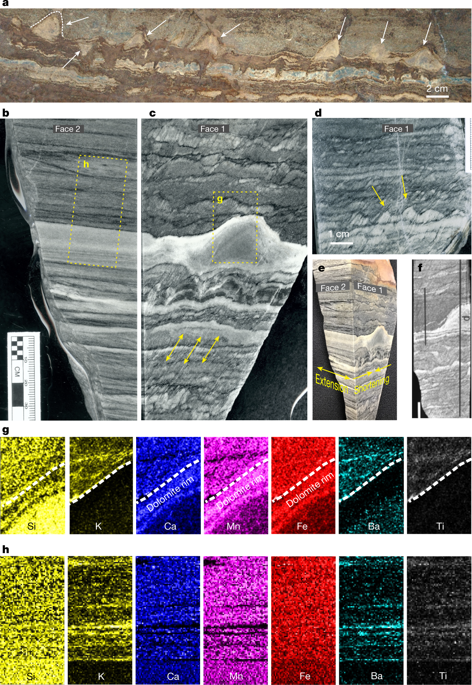Our official English website, www.x-mol.net, welcomes your
feedback! (Note: you will need to create a separate account there.)
Reassessing evidence of life in 3,700-million-year-old rocks of Greenland
Nature ( IF 50.5 ) Pub Date : 2018-10-17 , DOI: 10.1038/s41586-018-0610-4 Abigail C. Allwood , Minik T. Rosing , David T. Flannery , Joel A. Hurowitz , Christopher M. Heirwegh
Nature ( IF 50.5 ) Pub Date : 2018-10-17 , DOI: 10.1038/s41586-018-0610-4 Abigail C. Allwood , Minik T. Rosing , David T. Flannery , Joel A. Hurowitz , Christopher M. Heirwegh

|
The Palaeoarchean supracrustal belts in Greenland contain Earth’s oldest rocks and are a prime target in the search for the earliest evidence of life on Earth. However, metamorphism has largely obliterated original rock textures and compositions, posing a challenge to the preservation of biological signatures. A recent study of 3,700-million-year-old rocks of the Isua supracrustal belt in Greenland described a rare zone in which low deformation and a closed metamorphic system allowed preservation of primary sedimentary features, including putative conical and domical stromatolites1 (laminated accretionary structures formed by microbially mediated sedimentation). The morphology, layering, mineralogy, chemistry and geological context of the structures were attributed to the formation of microbial mats in a shallow marine environment by 3,700 million years ago, at the start of Earth’s rock record. Here we report new research that shows a non-biological, post-depositional origin for the structures. Three-dimensional analysis of the morphology and orientation of the structures within the context of host rock fabrics, combined with texture-specific analyses of major and trace element chemistry, show that the ‘stromatolites’ are more plausibly interpreted as part of an assemblage of deformation structures formed in carbonate-altered metasediments long after burial. The investigation of the structures of the Isua supracrustal belt serves as a cautionary tale in the search for signs of past life on Mars, highlighting the importance of three-dimensional, integrated analysis of morphology, rock fabrics and geochemistry at appropriate scales.In contrast to a previous study of 3,700-million-year-old rocks of the Isua supracrustal belt in Greenland, which presented fossil evidence of stromatolites (macroscopic remains of layered microbial communities), this study shows that these ‘stromatolites’ are features of deformation unconnected to the processes of organic life.
中文翻译:

重新评估格陵兰岛 37 亿年前岩石中的生命证据
格陵兰古太古宙上地壳带包含地球上最古老的岩石,是寻找地球上最早生命证据的主要目标。然而,变质作用在很大程度上消除了原始岩石的质地和成分,对生物特征的保存构成了挑战。最近对格陵兰岛 Isua 上地壳带 37 亿年前岩石的研究描述了一个罕见的区域,其中低变形和封闭变质系统允许保存主要沉积特征,包括假定的锥形和圆顶叠层石1通过微生物介导的沉降)。这些结构的形态、分层、矿物学、化学和地质背景归因于浅海环境中微生物垫的形成 3, 7 亿年前,地球岩石记录的开始。在这里,我们报告了新的研究,该研究显示了这些结构的非生物、沉积后起源。对主岩结构内结构形态和方向的三维分析,结合对主要和微量元素化学的特定纹理分析,表明“叠层石”更可能被解释为变形组合的一部分埋藏很久之后在碳酸盐变质变沉积物中形成的结构。对 Isua 上地壳带结构的调查在寻找火星上过去生命迹象的过程中起到了警示作用,突出了在适当尺度上对形态、岩石结构和地球化学进行三维综合分析的重要性。之前的研究 3,
更新日期:2018-10-17
中文翻译:

重新评估格陵兰岛 37 亿年前岩石中的生命证据
格陵兰古太古宙上地壳带包含地球上最古老的岩石,是寻找地球上最早生命证据的主要目标。然而,变质作用在很大程度上消除了原始岩石的质地和成分,对生物特征的保存构成了挑战。最近对格陵兰岛 Isua 上地壳带 37 亿年前岩石的研究描述了一个罕见的区域,其中低变形和封闭变质系统允许保存主要沉积特征,包括假定的锥形和圆顶叠层石1通过微生物介导的沉降)。这些结构的形态、分层、矿物学、化学和地质背景归因于浅海环境中微生物垫的形成 3, 7 亿年前,地球岩石记录的开始。在这里,我们报告了新的研究,该研究显示了这些结构的非生物、沉积后起源。对主岩结构内结构形态和方向的三维分析,结合对主要和微量元素化学的特定纹理分析,表明“叠层石”更可能被解释为变形组合的一部分埋藏很久之后在碳酸盐变质变沉积物中形成的结构。对 Isua 上地壳带结构的调查在寻找火星上过去生命迹象的过程中起到了警示作用,突出了在适当尺度上对形态、岩石结构和地球化学进行三维综合分析的重要性。之前的研究 3,











































 京公网安备 11010802027423号
京公网安备 11010802027423号